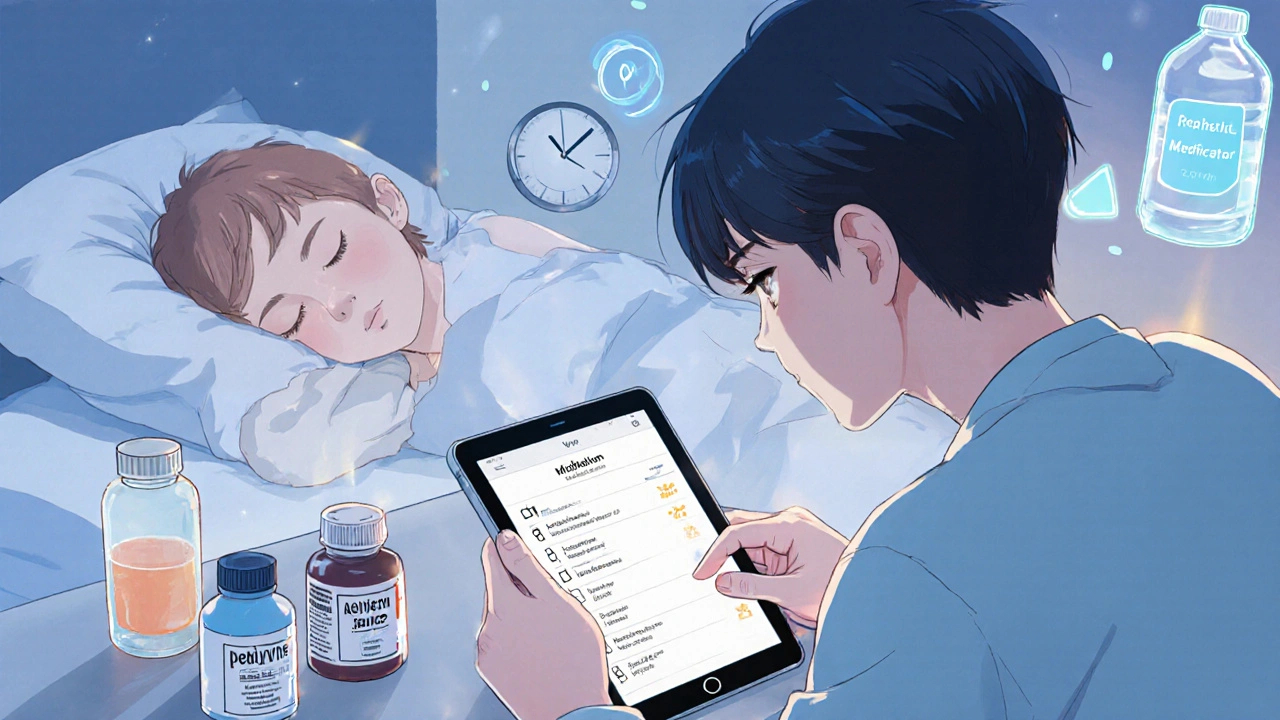How to Prepare for Pediatric Procedures with Pre-Op Medications: A Practical Guide for Parents
 Nov, 20 2025
Nov, 20 2025
Why Pre-Op Medications Matter for Kids
Going under anesthesia or sedation for the first time is scary-even for adults. For a child, it can feel like being pulled into a dark, unfamiliar world. That’s why pre-op medications aren’t just a medical formality-they’re a lifeline. Studies show that when kids get the right sedative before surgery, they’re 37% less likely to have crying fits, nightmares, or clingy behavior afterward. At Royal Children’s Hospital in Melbourne, parents reported satisfaction scores jumping from 6.2 to 8.7 out of 10 when pre-op meds were used properly. This isn’t about making kids sleepy. It’s about reducing fear, keeping them calm, and making the whole process safer.
When to Start Preparing: The 24-Hour Window
Preparation doesn’t begin the night before. It starts at least 24 hours out. That’s when families should review all medications their child is taking. Many parents don’t realize that daily medicines like asthma inhalers, seizure drugs, or even acid reflux pills need to continue on the day of surgery. The American Academy of Family Physicians says stopping antiepileptic drugs-even for a single dose-can trigger seizures during anesthesia. H2 blockers and proton pump inhibitors should also be given as usual to reduce stomach acid and lower the risk of aspiration. If your child takes insulin, GLP-1 agonists like semaglutide, or any other chronic medication, check with the anesthesiologist. New guidelines from June 2023 say semaglutide must be held for a full week before surgery because it slows stomach emptying and increases choking risk.
Fasting Rules: What Kids Can and Can’t Have
Fasting is confusing for families. Many think ‘nothing by mouth’ means no water, no sips, no anything. But pediatric guidelines are different from adult ones. Kids digest faster, so their fasting windows are shorter.
- Clear liquids (water, Pedialyte, apple juice, Sprite, 7-Up without pulp): Allowed up to 2 hours before arrival.
- Breast milk: Allowed up to 4 hours before.
- Formula or cow’s milk: Allowed up to 6 hours before.
- Solid foods: Nothing after midnight for children over 12 months.
Parents often get tripped up by what counts as a ‘clear liquid.’ Orange juice? No-it has pulp. Milkshakes? No. Gatorade? Only if it’s clear. Texas Children’s Hospital found that 28% of parents misunderstood this, and 15% gave their kids orange juice, thinking it was safe. That’s a mistake. Pulp can delay stomach emptying and raise aspiration risk. Stick to what’s listed. If you’re unsure, call the hospital. Better safe than sorry.
Choosing the Right Sedative: Midazolam, Ketamine, and More
Not all kids need the same sedative. The choice depends on age, anxiety level, and medical history.
- Oral midazolam is the most common. Given as a sweet liquid, it’s dosed at 0.5-0.7 mg per kg (max 20 mg). It works in 20-30 minutes. Kids usually drift off quietly, often still holding a parent’s hand.
- Intranasal midazolam is sprayed into the nose. It’s faster-works in 10-15 minutes-and avoids the struggle of swallowing. But 12% of kids get nasal irritation or sneezing fits, so it’s not for everyone.
- Intramuscular ketamine is used when a child is too anxious or uncooperative for oral or nasal meds. Dosed at 4-6 mg/kg, it takes 3-5 minutes to kick in. Kids enter a dissociative state where they’re calm but not fully asleep. Parents report it’s easier than fighting a screaming child. But there’s a catch: 8-15% experience emergence delirium-frightening dreams or agitation when waking. That’s why it’s reserved for specific cases.
Children with autism or developmental delays may need different approaches. At Royal Children’s Hospital, 40% of these kids required clonidine given 4 hours before surgery to reduce anxiety. Don’t assume one size fits all. Talk to the anesthesiologist about your child’s behavior and history.

Special Cases: Asthma, Seizures, and Obesity
Some kids need extra care.
Asthma: Kids with asthma should get their rescue inhaler (like albuterol) 30 minutes before surgery. CHOP data shows this cuts intraoperative bronchospasm by 40%. Nitrous oxide (laughing gas) should be avoided-it can trigger airway tightening in kids with severe asthma, increasing risk by 25-30%.
Seizure disorders: Never stop seizure meds. Even one missed dose can lead to a seizure under anesthesia. The AAFP guidelines are clear: give them with a small sip of water on the day of surgery.
Obesity: New 2025 data from CHOP shows standard midazolam doses don’t work well in overweight kids. In 35% of cases, the usual dose was too low. Now, obese children may need 20% higher doses. This is a recent change-many clinics haven’t caught up yet. Ask if your child’s weight affects dosing.
What Happens on the Day of Surgery
On the morning of the procedure, follow these steps:
- Give any approved medications with a small sip of water.
- Ensure your child hasn’t eaten or drunk anything past the cutoff times.
- Bring a comfort item-a stuffed animal, blanket, or tablet with a favorite show.
- Arrive on time. Late arrivals can delay sedation timing and risk the procedure being canceled.
- Be ready to answer questions: ‘Has your child had a cold or cough in the last 2 weeks?’ ‘Any recent fevers?’ ‘Any trouble breathing?’
Don’t rush. Take a breath. The team has done this hundreds of times. Your calm helps your child feel safe.
Common Mistakes Parents Make
Even well-meaning parents make errors that delay or endanger procedures.
- Stopping seizure meds: This is the #1 error. 32% of medication mistakes involve this.
- Wrong sedative dose: 27% of errors come from miscalculating weight-based doses. Always double-check with the nurse.
- Ignoring fasting rules: Giving juice, milk, or snacks too close to surgery is the second most common issue.
- Not telling the team about allergies or past reactions: A child who had a bad reaction to anesthesia before needs special planning.
- Waiting until the last minute to ask questions: Don’t wait in the waiting room to find out if your child can have a lollipop. Ask during the pre-op visit.

What to Expect After the Medication
Once the sedative is given, your child will likely become drowsy. They may not remember you leaving the room. That’s normal. Some kids giggle or get quiet. Others just close their eyes. The goal isn’t to knock them out-it’s to make them calm and cooperative. You’ll be asked to stay until the medication takes effect. Then you’ll say goodbye in the pre-op area. The team will take your child to the operating room. Most kids wake up in recovery within 30-60 minutes. If they got ketamine, they might be a bit wobbly or confused at first. That’s expected. Nurses will monitor them closely.
How to Know the Protocol Worked
Success isn’t just about no vomiting or no fever. It’s about behavior. If your child wakes up calm, doesn’t cry uncontrollably, and lets you hold them without fighting, the pre-op meds did their job. At CHOP, hospitals using standardized protocols saw 22% fewer canceled surgeries because kids were calmer and easier to manage. At RCH Melbourne, nurses use the Modified Yale Preoperative Anxiety Scale to measure success. A drop from 8.2 to 3.1 on that scale means the child went from terrified to manageable. That’s the goal.
What’s New in 2025
Technology is changing how pre-op meds are given. Most major children’s hospitals now use digital checklists and apps to help parents track fasting times, medication schedules, and appointment reminders. In 2023, 78% of top hospitals piloted these tools. Some are even testing AI that adjusts doses based on genetic markers that affect how kids metabolize drugs. This isn’t science fiction-it’s happening now. But the core principles haven’t changed: know the rules, ask questions, and trust the team.
When to Call for Help
Call the hospital if:
- Your child develops a fever, cough, or wheezing in the 48 hours before surgery.
- You accidentally gave food or drink past the cutoff time.
- Your child had a bad reaction to sedation before.
- You’re unsure whether to give a regular medication.
Don’t guess. Call. A 10-minute call can prevent a 3-hour delay or a dangerous situation.


Kimberley Chronicle
November 20, 2025 AT 14:40Just wanted to say how impressed I am by the granularity of the dosing protocols here-especially the weight-based adjustments for obese pediatric patients. The 20% increase in midazolam is backed by solid CHOP data from early 2025, and I’m thrilled more hospitals are adopting it. Too many still default to adult protocols, which is terrifying when you consider pharmacokinetic differences in adipose tissue distribution. Also, the AI dose-adjustment pilots? That’s not sci-fi-it’s the future of precision pediatric anesthesia. We need more institutions investing in this.
Shirou Spade
November 22, 2025 AT 12:48It’s strange how we treat children’s fear as a problem to be suppressed rather than a signal to be understood. Sedatives quiet the body, but they don’t always quiet the mind. I wonder-if we spent as much energy on emotional preparation-storytelling, play therapy, parental presence in induction-as we do on pharmacology, would we need half the drugs? Maybe the real breakthrough isn’t in the vial, but in the voice that says, ‘I’m right here.’
Pallab Dasgupta
November 24, 2025 AT 07:09Y’all are overthinking this. My kid got ketamine IM at 4.5 mg/kg, screamed like a banshee for 2 minutes, then passed out like a log. Woke up 45 minutes later, asked for pizza, and didn’t cry once. No drama. No tears. Just give the damn drug. The nurses know what they’re doing. Stop Googling ‘anesthesia nightmares’ at 3 AM. You’re not helping. I’ve been through this three times. Trust the process. And for god’s sake, don’t give your kid orange juice. I saw a mom try that last month-hospital delayed the whole OR schedule. Don’t be that person.
Ellen Sales
November 26, 2025 AT 04:44So… I’m a single mom of a 7-year-old with autism and I just want to say thank you for mentioning clonidine. We were told ‘just try midazolam’-but he’d scream, kick, and bite. We tried clonidine 4 hours before-quiet, calm, held my hand all the way to the door. The nurse cried. I cried. This isn’t just medical advice-it’s human. Please share this with every pediatric clinic. And yes-I gave him water with his meds. I read the guidelines. I didn’t guess. I didn’t wing it. I read. I listened. And my child is safe. Thank you.
fiona collins
November 26, 2025 AT 11:27giselle kate
November 26, 2025 AT 22:04Why are we medicating kids just to make them quiet? In my country, we don’t drug children to manage their fear-we teach them courage. This whole system feels like a corporate convenience wrapped in medical jargon. Why not train parents to hold their kids? Why not let them cry? It’s natural. The system wants compliance, not connection. And don’t even get me started on AI dosing-next they’ll be scanning DNA before a tonsillectomy. This isn’t medicine. It’s control dressed in white coats.